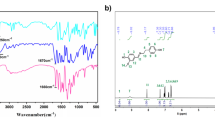Abstract
New piperazine-based polymerizable monomers were synthesized to modify adhesive properties of fluoromethacrylic copolymer. The new monomers showed good ability to radical copolymerization with fluoroalkylmethacrylates. Amorphous glassy terpolymers were prepared with random distribution units in the macromolecules and weight-average molecular weight (M w) 110,000–130,000. The ratio of monomer units in the obtained copolymer is close to the ratio of the monomers in the starting mixture. The terpolymers exhibited excellent solubility in tetrahydrofuran (THF), acetone and α,α,α-trifluorotoluene (TFT). The introduction of new monomers to the macromolecules increased the glass-transition temperatures (T g) of terpolymers, significantly improved their thermal stability and adhesion to the aluminum substrate.







Similar content being viewed by others
References
Puklin E, Carlson B, Gouin S, Costin C, Green E, Ponomarev S, Tanji H, Gouterman M (2000) Ideality of pressure-sensitive paint. 1. Platinum tetra(pentafluorophenyl)porphine in fluoroacrylic polymer. J Appl Polym Sci 77:2795–2804
Obata M, Matsuura N, Mitsuo K, Nagai H, Asai K, Harada M, Hirohara S, Tanihara M, Yano S (2010) Oxygen-sensing properties of 5,10,15,20-tetraphenylporphinato platinum(II) and palladium(II) covalently bound on poly(isobutyl-co-2,2,2-trifluoroethyl methacrylate. J Polym Sci A Polym Chem 48:663–670
Tanaka Y, Araki N, Hirohara S, Yano S, Mitsuo K, Asai K, Harada M, Toyoji Kakuchi T, Ohtsuki C (2005) Synthesis of poly(isobutyl-co-2,2,2-trifluoroethyl methacrylate) with 5,10,15,20-tetraphenylporphinato platinum(II) moiety as an oxygen-sensing dye for pressure-sensitive paint. J Polym Sci A Polym Chem 43:2997–3006
Gouin S, Gouterman M (2000) Ideality of pressure-sensitive paint. II. Effect of annealing on the temperature dependence of the luminescence. J Appl Polym Sci 77:2805–2814
Peterson J, Fitzgerald VF (1980) New technique of surface flow visualization based on oxygen quenching of fluorescence. Rev Sci Instrum 51:670–671
Troyanovsky I, Sadovskii N, Kuzmin M, Mosharov V, Orlov A, Radchenko V, Phonov S (1993) Set of luminescence pressure sensors for aerospace reseach. Sens Actuators B 11:201–206
Bell JH, McLachlan BG (1993) Image registration for luminescent paint sensors. AIAA paper 93-0178, 31st Aerospace sciences meeting, Reno, Nevada
Hah H, Sakai T, Asai K, Nishide H (2003) Synthesis of poly(ethynylplatinum-porphyrin) and its application as an oxygen pressure-sensitive paint. Macromol Symp 204:27–36
Budd PM, McKeown NB (2010) Highly permeable polymers for gas separation membranes. Polym Chem 1:63–68
Mahkam M, Assadi MG, Tajrezaiy Z (2007) Synthesis and characterization of new polymer systems containing 4-silylmethylstyrene units. J Chin Chem Soc 54:759–762
Huang SH, Hu CC, Lee KR, Liaw DJ, Lai JY (2006) Gas separation properties of aromatic poly(amide-imide) membranes. Eur Polym J 42:140–148
Asai K, Amao Y, Iijima Y, Okura I, Nishide H (2002) Novel pressure-sensitive paint for cryogenic and unsteady wind-tunnel testing. J Thermophys Heat Transf 16:109–115
Butt A, Chughtai A, Ahmad J, Ahmad R, Majeed U, Khan IH (2007–2008) Theory of adhesion and its practical implications a critical review. J Fac Eng Technol 15(1):21–45
Rivas BL, Pooley SA, Luna M (2000) Chelating properties of poly(N-acryloyl piperazine) by liquid-phase polymer-based retention (LPR) technique. Macromol Rapid Commun 21:905–908
Powers JP, Sun D, Yan X (2007) 1-Phenylsulfonyl-diaza heterocyclic amide compounds and their uses as modulators of hydroxsteroid dehydrogenases. Patent WO 2007/111921 A1
Danusso F, Tanzi MC, Levi M, Martini A (1990) Polymers and copolymers of N-acryloyl-N′-phenyl-piperazine. Polymer 31:1577–1580
Jellinec HHG, Lub MS (1968) Thermal degradation of polymethylmethacrylate. Energies of activation. Macromol Chem 115:89–102
Kashiwagi T, Inaba A, Brown JE, Hatada K, Kitayama T, Masuda E (1986) Effects of weak linkages on the thermal and oxidative degradation of poly(methyl methacrylates). Macromolecules 19:2160–2168
Inoue E, Tsuchiya M, Tshimaru K, Kojima T (2002) Thermograviometric studies of poly(methyl methacrylate), poly(tetrahydrofuran) and their blands. J Therm Anal Cal 70:747–753
Acknowledgments
This work was supported by the Russian Science Foundation (No. 14-13-00826).
Author information
Authors and Affiliations
Corresponding author
Rights and permissions
About this article
Cite this article
Shundrina, I.K., Bukhtoyarova, A.D., Russkikh, V.V. et al. Synthesis and properties of novel random copolymers made from N-acryloyl piperazine-based monomers and fluoroalkylmethacrylates. Polym. Bull. 72, 2783–2796 (2015). https://doi.org/10.1007/s00289-015-1435-z
Received:
Revised:
Accepted:
Published:
Issue Date:
DOI: https://doi.org/10.1007/s00289-015-1435-z




